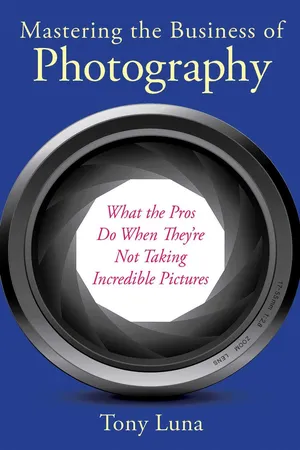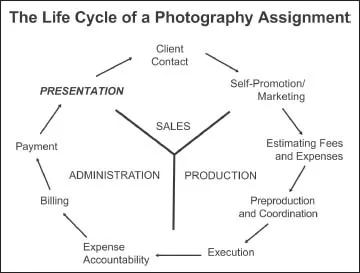Presentation
The crucial first step in the “Life Cycle of a Photography Assignment” is to put together a presentation of the work that best announces to the professional world who you are and what you want—no, what you need—to say as an artist.
That last sentence was full of phrases that can stop anyone who is not serious about being a professional photographer in their tracks. For example, out of a universe of options, where does one begin to know what to shoot and then how does anyone select what is right to show? How many images should I show? What is the best way to show my work? To whom should I show my work? What is my competition up to and how can I separate myself from them? It’s enough to make the faint of heart hyperventilate and give up the idea of being a professional photographer entirely.
But that’s not you. You have picked up this book, so already you have demonstrated that your curiosity has overtaken you and you want to know what you have to do to prepare for success in the field. So take a moment, take a deep breath, and let’s focus on what it will take for you to become successful.
What to Shoot? Five Components of Success
Before I launch into this excursion into the foundations of success, let me mention that in my first book I devoted a little over a page to what I then called “The Three Elements of Success” in the introduction. But that was seven years ago and I now submit to you that there are some additional elements that I have included in this work that have made themselves evident through time and reflection. Who knows, if I write another book in a few years, and give it a little more thought, there could be more elements, and I encourage you to add your own, relative to your circumstances, but for the time being I offer you the following five components.
1. Playfulness
When you read about successful people, or you hear them interviewed, there are some common attributes they share which outline the stages a person usually goes through to reach, and even exceed, their goals. The first stage is so simple it is elusive, yet it is profound in its implications. That stage is the playfulness stage. The importance of playfulness cannot be overstated because it is through play that we discover things about ourselves that are not obvious yet they are powerful motivators. When we play we become childlike in that we accept the humility to believe that we know nothing and are willing to learn. I love to watch children playing with a stick and watching them invent worlds waving that stick like a sword, or drawing in the sand, or conducting an imaginary symphony. The same applies to the world of photography in that a camera is a magical instrument that allows you to capture discreet segments of time and preserve them to be enjoyed or analyzed later by yourself or potentially by millions of viewers.
Pablo Picasso famously said, “Every child is an artist. The problem is how to remain an artist when we grow up.”
© SteveMcCurry
2. Passion
Eventually you find yourself being called to, or drawn toward, certain subject matter and you begin to isolate your interests around that topic to know more about it. That isolation, or focus (pun intended), starts to intrigue you and you want to know more about it. This is a very fascinating stage because, depending on the intensity of the topic, your involvement could be anywhere from initially casual to eventually obsessive, but the topic has the ability to hold your attention and the rest of the world melts away when you are under its spell. When the topic intrudes into your everyday thoughts, then you have reached the passion stage. You find yourself seeing things a certain way, examining shadows, lining up telephone poles to emphasize perspective, tilting your head and framing subjects to bring out the most of your vision. It is sometimes referred to as drive, or motivation, or commitment, or fire in the belly, but passion is the door that opens to another world that fascinates and entices. This is the early stage of falling in love with seeing.
Just as was described in the last chapter, many photographers can identify the moment the idea of becoming a photographer hit them. Everybody has to start somewhere, even the great ones. Steve McCurry has long established himself as the preeminent documentarian of the human condition around the globe. Here, in his own words, he shares how the powerful photo pictured here influenced him: “This photograph is significant for me, because it was one of the first images I made on one of my earliest photographic journeys. I was struck by the juxtaposition of two worlds in this image—the man sleeping on the street when just feet away there was luxury furniture on display.”
His searing images have inflamed the imagination and inspired generations of photographers and artists. He shared this insight, “My father had always been interested in photography. He had an old Argus C-3 35-mm camera and a box of slides he had taken when he was a young man. While studying in filmmaking and theatre, I took a series of courses in fine art photography. We had a series of self-assigned projects: portraits and our own independent study. While in college, I made trips during the summer to Central America, Africa, and Europe. I hitchhiked through Mexico, Guatemala, Honduras, El Salvador, Nicaragua, and Panama. I was photographing along the way and then came back to Pennsylvania. I spent a lot of time looking at books by such photographers as Walker Evans, Diane Arbus, Andre Kertesz, Dorothea Lange, and Henri Cartier-Bresson. My first approach to photography was influenced by these photographers. I was always drawn to street photography.”
His choice of words, “I was always drawn to street photography” is an understatement of the highest order. It is the fact that he has always been drawn to it that fascinates me. The word itself implies that street photography calls out to him; it motivates him and invades his thoughts. Because of that connection, his images have opened up the world for all of us and he has shown us how similar we human beings are beyond our differences.
3. Practice
About the time that you admit there is something going on inside your creative self, you also determine that there is a lot more to learn. You seek out teachers to help you learn about and refine new skills that will help you delve deeper into the beauty of your discovery. From those teachers you select the ones who push you the most, because you crave getting as close to excellence as you can. Some of those selected teachers become mentors over time with whom you realize you share some special bond brought about by your mutual appreciation for the work. This is a stage in which you develop your work ethic and your dedication, and you begin to measure your work against those who have preceded you. This is the 10,000-hour rule phase that Malcolm Gladwell has written about in his national bestseller, Outliers. Sweat equity is the currency of your efforts, but you don’t mind the work—in fact you relish it—because every involvement becomes a chance to prove yourself and to move higher in achieving your goals.
4. Planning
After intense research and rehearsal, you start to get antsy about the future. You think maybe, if you continue growing at this pace, just maybe you could make a living doing this kind of work. At first it seems like a pipe dream, but then you begin inquiring what you will need to devote your energies to your work and make it a way of life. People start asking you for your work, and some offer to pay you for your art. You begin asking around and making notes to yourself and creating scenarios in which you are living your passion and your passion is making you a living. Plans start to be made about where you will need to live, and how you will start your career, and how much money you will need to make to get started, and then to grow. Plans have a way of providing fuel and one thing leads to another until, one day you look back to see how far you have come, and you look to the future to see how far you wish to go.
5. Perseverance
But nothing will come easily because to be fully appreciated, your success has to be earned. You will be happy you had those sweat equity lessons back in the practice stage, because those long nights and tedious hours lessen the load for you now. You have to stick with it and make the commitment to dig in and carry on. Sometimes you are driven by guilt, sometimes driven by necessity, but wherever you find the energy you are fueled by determination to move ever forward and not become the victim of mediocrity, because mediocrity is toxic and can erode the grandest efforts with nagging self-doubt and persistent pessimism. Perseverance gives you the purpose to carry on, rising above each challenge.
Where Do I Begin?
Whenever someone asks me to help him or her put together a portfolio, the first thing I ask is, “How do you describe what you love to shoot?” It’s a simple question, but interestingly enough it is curious how many people have trouble defining what they love to shoot.
In the case of anyone who does not have an extensive collection of images, it is necessary to kick-start their curiosity. For that I go back to when I was a youngster and remember what we did before toys and games gave us rules and limited our choices to discover on our own. When I was young, my sister (who is older than me) and I would go to the library during the summer because it was air-conditioned, safe, and a good place for her to study. To keep me occupied we had a game we played in which she would take me by the hand, and while I closed my eyes, she would guide me down the library aisles until I would say, “Stop.” She would then let me reach out (eyes still shut) and grab a book arbitrarily off the shelf. I would sit down and try to read it, and if it did not hold my attention for say, five minutes, I would put it back and we would start the process all over again. It was a game, something playful, but it was also a chance to discover things I would never have been exposed to otherwise. Sometimes we have to let our instincts call out to us to get us started in a direction and let serendipity have a field day.
Borrowing from that experience I brought that idea forward for one of the classes I teach called “Professional Presentation,” at the Art Center College of Design. In one of the initial assignments I give in order to identify students’ passions, I ask them to go to a place where a large number of magazines are sold and simply stand in front of the magazines and look at them. After scanning the magazine covers for a good while I ask them to pick out a magazine that they would not normally choose, but one that has called out to them. At first they may think this is some sort of new-age gimmick, but eventually they discover some topic or field of interest they had no idea existed. The idea here is to start paying attention to the images that surround us every day and to examine if there is something hidden that you would like to know more about using your photography skills and your life experiences to further your investigation. I once had a student who had a hard time with this assignment because he said, “Nothing interests me.” He was only interested in getting through school. After a little conversation I said, “Maybe you are trying too hard, you are thinking too much and you are not using your instincts. Go back and try it again.” I sent him out for another trip to the magazine stand and, after a few visits, he came back to class all excited with a big smile on his face. When I asked him to present his findings he stood in the front of the class and announced what he had discovered, “Do you realize that man is the only animal which decorates his food? You don’t see a lion take the time to put a piece of parsley next to a wildebeest before he devours it! No, well I am going to do a body of work on how man is the only animal that makes his food look good before he eats it.” That revelation set him off on an adventure and gave him a unique piece for his portfolio.
For those who have been shooting lots of images but are still not sure of the direction they should take, I suggest that they bring in as many photos they feel express what they enjoy the most. They typically say that everything interests them and they are having trouble finding something they can sink their teeth into. At that point I instruct them to bring any photos, any subject matter, and I tell them that the photos must be printed small (approximately 3 × 5” or 5 × 7”), and on cheap paper. I don’t want them to spend a lot of money on this exercise; I just want to get as big a picture of what they think are their better images and help them define a direction they can pursue. Furthermore, I don’t want to see huge batches of images on a digital screen because it is impossible to categorize them given the limitations of technology and the flexibility and freedom necessary make as many categories as needed.
Now, after reading the paragraph on playfulness you can see the direction in which I am headed. Once students bring in their hundreds of images, we lay the images out on a large table, or series of tables. This is where the fun begins because I then start moving around the images and putting them into categories by subject matter. A funny thing happens at this moment because the photographer usually feels compelled to say, “Now be brutally honest and tell me which ones work for you, and which don’t.” I work quickly and quietly going mostly by instinct as to which photos belong together. I can feel their anxiety as they try to figure out my logic, and they sometimes wonder out loud why I placed one of their favorite images in one pile rather than another. A key element here is to listen to what they say when I shuffle the images around. Their comments can reveal what they were feeling when they shot certain images and can give an indication as to which images they enjoyed shooting the most and why. Sometimes they become apologetic because the light wasn’t right, or the model wasn’t cooperating, or they were using the wrong equipment, all of which indicate a lack of attention to detail and forethought. The comments that are made during this exercise can open a door to your creative (as well as personal) strengths and weaknesses.
Personally I find this procedure fascinating because it sometimes reveals a direction that the artist hadn’t considered. They may have fancied themselves as a travel photographer, but their work reveals a deeper interest in lifestyle; they may have thought they were destined for big things in fashion photography, but they have a strength in portraiture work that they hadn’t noticed before. The goal at this stage is not to come up with a title for them but rather to see what comes naturally to them and to see how they can dig deeper into a particular area so they can find their own voices.
I have talked about this process with a good many photographers, artist representatives, art buyers, and art directors and they all agree that there is something very clear that emerges when you look at a large inventory of a person’s body of work. A theme starts to make itself known, and whatever it is, that theme has to be reckoned with. In an interview with Harvey Chua, who is the general manager of Adphoto, Inc., an established photo studio in Manila, the Philippines, and a teacher at St. Benilda College, School of Design and Arts, in the photography program, she had this to say:
“The exercise that we do in class to help them find what they are passionate about is actually inspired by the process that you described in your book, How to Grow as a Photographer: Reinventing Your Career. While your aim is to help established photographers to rekindle their passion; with my students, they are in the initial stage of finding out what they would like to do. You help older photographers to rediscover what they are passionate about by asking them to bring out their photos and sorting them into genres, and pointing out that what they have more of might really be what they are passionate about. Since many of these students do not have an extensive collection of their own photography to sort, I allow them to graze on the Internet for photos that they wished they had taken, until they have about a hundred photographs. They do this without limiting themselves to any particular genre. Then, following the procedure that you had suggested for older photographers, they sort the photos into different photography specializations, and see which pile has more. I also ask them to do some kind of biofeedback by being aware of their feelings towards the photographs that they are reviewing.
“My youngest daughter, Sacha, came up with a similar exercise, not for photography but for life. She calls it . . . her ‘Happiness Map.’ Combining the two inspirations from you and from my daughter, I call the exercise we do in class ‘Photomapping.’ It has been very helpful to my students in defining where their passion in photography lies. I also advised them that, even after graduating and after a few years into their careers, they should periodically review their bodies of work and see if they are still on track.
“I tell them, you can still change. This is not carved in stone, but for now you need to define what you are passionate about. All my students go through the exercise that you described in your book.”
When we continued on the topic, Harvey revealed another method she uses to spark some insights into her students’ motivations. Here is what she had to say, “I have another exercise. Since they [my students] don’t like sitting down and doing deskwork, I ask my students to write twenty adjectives about themselves, whatever comes to their minds without thinking too much. Then we put them together and we have the usual classifications about different graphic genres. For example, if they say they are athletic, we say, okay you can be in photojournalism, sports photography, travel, documentary. If you are not a morning person then it is going to be hard to be in landscape because you have to wake up early. I tell my students that, for example, my husband John, in the beginning of his career as a photographer was very shy. He avoided conversing with clients and his answers were always short, almost monosyllabic. Understandably, he was just interested in shooting products; he didn’t want to shoot talent. I honored him for what he was and got him only the type of work that he wanted to do. But now, forty years later, he is very talkative, very gregarious, and the kind of photography that he does has also changed to reflect the changes in his personality.
“I advise my students to start with who they are and where they fit. There was this article about National Geographic photographers. Almost everyone aspires to be a National Geographic photographer, but the article said that if you knew the work that National Geographic photographers did, you probably would not want to be a National Geographic photographer. There’s the long hours and physically exhausti...



